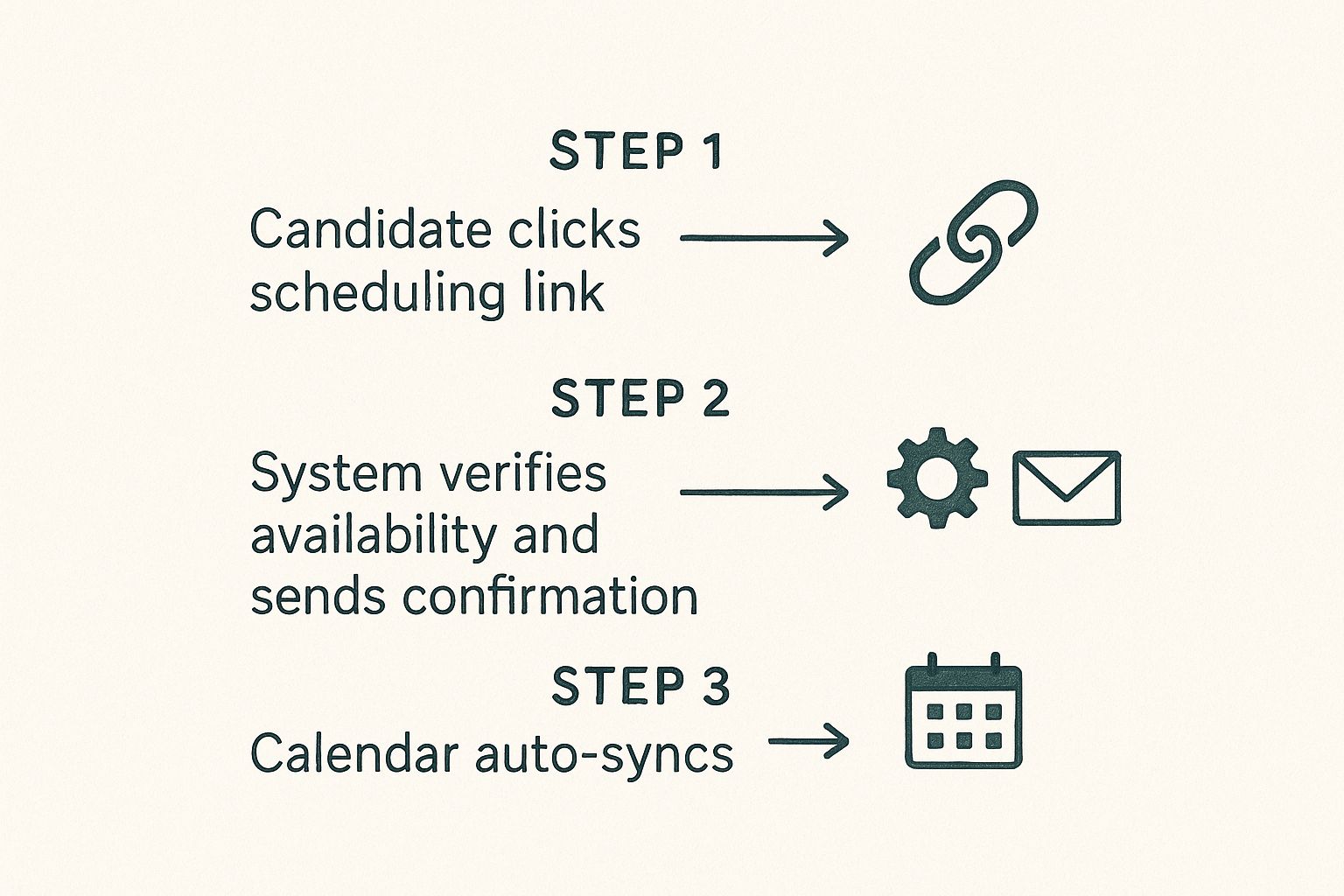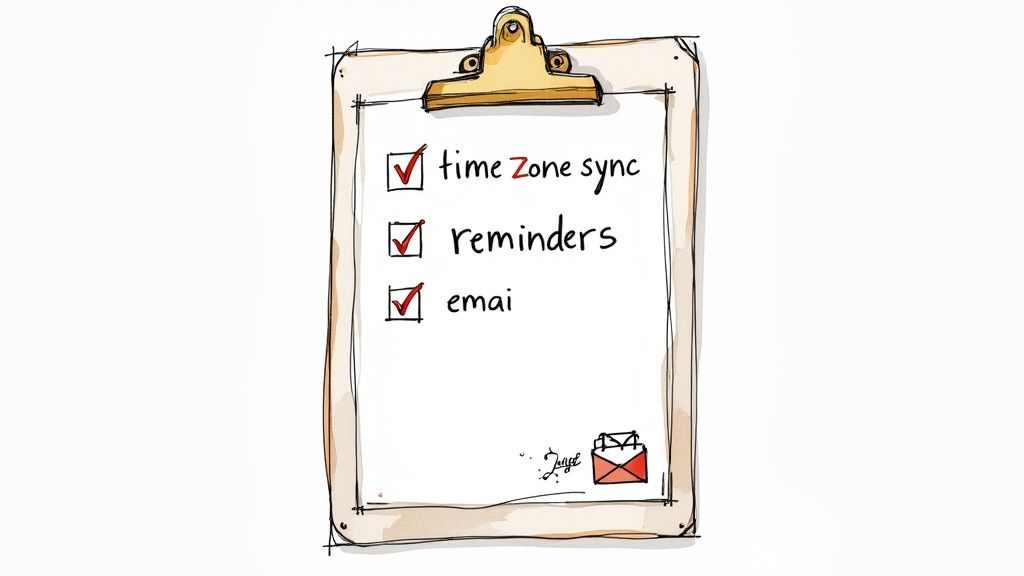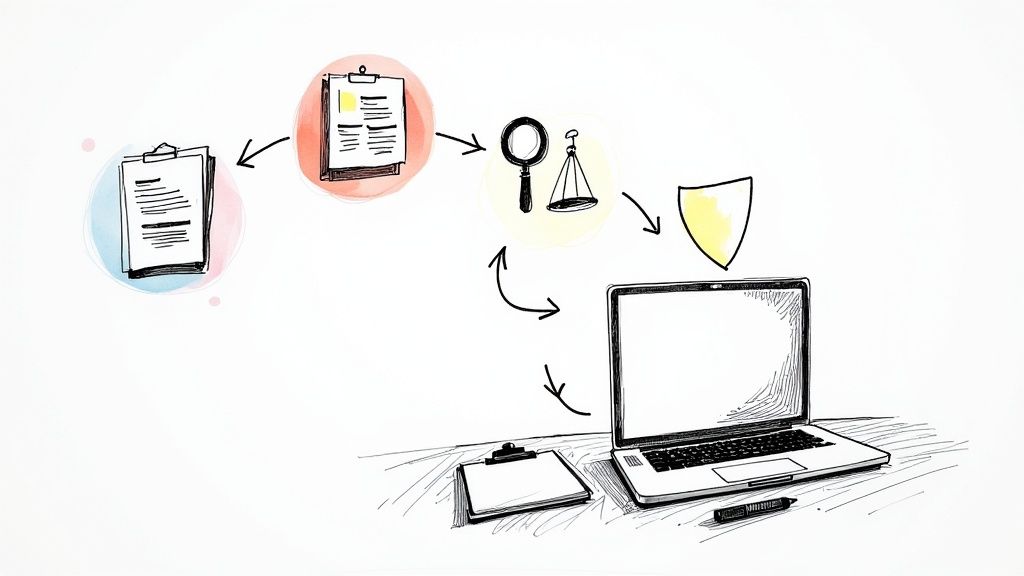Let's be real: manual interview scheduling is a productivity black hole. It’s that one task everyone swears takes "just five minutes," but secretly balloons into a week-long email chain of “Does Tuesday at 2 PM work for you?” It's the silent killer of your hiring velocity and a surefire way to give top talent a clunky, frustrating first impression.
We've been there. We've lived in that spreadsheet hell. And we're here to tell you there's a better way.
The High Cost of Playing Calendar Tetris

If you're still scheduling interviews by hand, you’re not just wasting time—you're actively setting money on fire. The real cost isn't just the hours your recruiters spend chasing down availability. It’s the opportunity cost of losing A-list candidates to competitors who are simply faster. More organized. Better.
This isn't some fuzzy theory; it's a painful reality. The true cost of manual scheduling is rooted in the time spent on mind-numbing, repetitive tasks. A helpful guide on automating repetitive tasks can shed more light on just how deep these inefficiencies run. When your team is buried in administrative quicksand, they aren't sourcing, engaging, or closing candidates. They're just very expensive receptionists.
The $500 Hello
Ever calculated the real cost of that first screening call? Let's do some quick, slightly painful, back-of-the-napkin math. Say it takes a recruiter an average of 20 minutes of email ping-pong just to lock down one 30-minute interview. That’s nearly an hour of a salaried employee's time for a single candidate.
Now, multiply that by dozens of candidates for just one open role. The hours stack up fast, and those hours have a very real price tag. That "quick chat" suddenly has the administrative overhead of a small, soul-crushing project.
Here's the kicker: A poor scheduling experience is more than just an annoyance. For 62% of candidates, it's their very first impression of your company. A clunky process screams one thing: "We're disorganized."
Losing the Race Before It Starts
In a competitive talent market, speed isn't just a feature—it's everything. While you’re stuck in an email loop trying to find a time that works for three different hiring managers, your top candidate has already received and accepted an offer from the company that let them book a slot in two clicks. Game over.
The painful truth is that the best talent has options, and they aren't waiting around for you to get your calendar in order. Every day wasted on manual coordination is another day your competitors get closer to signing your dream hire. This isn't just an inefficiency; it's a strategic vulnerability.
- Candidate Drop-Off: The longer the scheduling process drags on, the more likely candidates are to lose interest or ghost you entirely.
- Damaged Employer Brand: A frustrating, slow process quietly poisons your reputation. Great candidates talk, and they'll remember the company that made scheduling a nightmare.
- Recruiter Burnout: Forcing skilled talent acquisition pros to spend a third of their week on administrative tasks is the fastest way to kill morale and drive them straight to your competitors.
This is why automated interview scheduling isn't some fancy luxury—it's a competitive necessity. It’s the difference between being a proactive talent magnet and a reactive scheduling admin.
How Automated Interview Scheduling Actually Works

Let’s get one thing straight. When we say "automated" scheduling, we're not talking about some cold, unfeeling robot making hiring decisions. That’s a common misconception. Good automated scheduling isn’t about replacing the human touch; it’s about firing the painfully inefficient admin work that humans were never meant to do in the first place.
Think of it as the world’s most efficient personal assistant, working for you 24/7. This assistant knows your interviewers' calendars inside and out—including their standing Wednesday lunch and that blocked-off Thursday morning for "deep work." It never double-books, never gets tripped up by time zones, and never sends a passive-aggressive follow-up.
Its only job is to kill the back-and-forth friction so your team can get back to what they do best: talking to great candidates.
The Calendar Whisperer
So, how does the magic happen? It’s a lot simpler than you'd think. The system plugs directly into your team’s calendars—Google Calendar, Outlook, you name it—and reads their real-time availability. From there, you just set the rules.
You can configure details like:
- Interview Types: A 30-minute phone screen with one recruiter has totally different availability than a 90-minute technical panel with three senior engineers.
- Buffer Times: Automatically add 15-minute breathers between calls so your team can grab a coffee and actually remember who they're talking to next.
- Daily Limits: Cap the number of interviews anyone has in a single day. Your team will thank you.
Once the rules are in place, the system gives the candidate a simple, clean scheduling link. They see only the pre-approved slots that work for everyone. They click a time, and poof—everyone gets a calendar invite. No more email tag. No more drama.
It's a fundamental shift. Instead of forcing candidates to jump through hoops just to find a time, you empower them with control. That small act of respect says more about your company culture than your careers page ever will.
From Booking to Showtime
The work isn't finished once the interview is on the calendar. A smart automated system manages the entire pre-interview journey, making sure no one drops the ball. This is what separates a powerhouse tool from a basic calendar plugin.
This is also where the real value of comprehensive recruitment automation software comes into play. Scheduling is just one piece of a much bigger puzzle. The system takes over all the tedious but critical tasks that are so easy for busy humans to forget.
These include things like:
- Automated Confirmations: The moment a time is picked, a confirmation email zips out to both the candidate and the interviewers with every detail they need.
- Smart Reminders: It sends timely reminders—say, 24 hours and 1 hour before the meeting—to slash no-show rates.
- Effortless Rescheduling: If a candidate needs to reschedule, they can do it themselves with the original link. No need to kick off a new, awkward email thread.
This isn't just about making life easier; it's quickly becoming the industry standard. Recent surveys show that 51% of recruiters are already using scheduling software, with another 26% planning to adopt it soon. These tools can save a single recruiter anywhere from two to ten hours every single week—time that’s much better spent finding and talking to talent.
The Real ROI of Ditching Your Spreadsheet
Still tracking interviews on a spreadsheet? Let's be brutally honest. Sticking with that old system is like trying to win a Formula 1 race on a bicycle. It’s not just inefficient; it’s costing you top talent, and the price tag is way higher than you think.
This isn’t about fuzzy, feel-good benefits. We're talking about hard numbers and strategic wins that directly hit your bottom line. The return on investment you get from finally ditching that spreadsheet is built on three pillars: raw speed, candidate experience, and actionable data.
Nail these three, and you’re not just hiring better—you’re building a competitive moat around your talent strategy.
Speed to Hire Is Your New Secret Weapon
In hiring, the early bird doesn't just get the worm; it gets the A-list engineer before their inbox explodes. Automated interview scheduling crushes the time it takes to get a candidate on the calendar, turning an agonizing, multi-day email chain into a process that takes mere minutes.
That newfound speed has a direct, measurable impact on your overall time-to-hire.
This isn't just a minor inconvenience we're solving. A staggering 60% of companies report that their time-to-hire is getting longer, largely thanks to scheduling fumbles and endless back-and-forth. Every single day you delay is another window of opportunity for your competitors to swoop in and make an offer.
The process becomes ridiculously simple, moving from a candidate's click to a synced calendar in three frictionless steps.

This kind of flow isn't just about convenience. It's a strategic advantage that compresses your entire hiring cycle.
Experience Is Everything (No, Really)
You can offer the coolest office perks and have the most inspiring mission statement on the planet, but if your scheduling process feels like navigating a bureaucratic maze, you’ve already lost. A seamless, candidate-driven scheduling experience is one of the most powerful—and underrated—drivers of offer acceptance rates.
When a candidate can book a time in two clicks from their phone, it sends a powerful message: "We are modern, we are efficient, and we respect your time." It’s a subtle flex, but it makes a huge impression.
The real ROI here isn't just about saving time; it's about preventing lost opportunities. It's a similar principle to how top-tier SMS automation tools for franchises emphasize the critical role of 'speed to lead' to secure valuable prospects before they go elsewhere.
The goal isn't just to schedule an interview; it's to make the candidate want to work for you before they've even spoken to a hiring manager. A great scheduling experience is your first, best chance to do that.
Your Spreadsheet Is Hiding the Truth
Here’s the thing your spreadsheet will never tell you: where the real bottlenecks are hiding. Is one particular engineering manager always slow to confirm times? How long does it actually take to move a candidate from a phone screen to a panel interview?
Manual tracking makes these questions impossible to answer with any real accuracy.
Automated systems, on the other hand, turn that chaos into clarity. Suddenly, you have a dashboard that reveals:
- Stage-by-stage velocity: Pinpoint exactly where your process is slowing down.
- Interviewer performance: See who is responsive and who might need a gentle nudge.
- Candidate drop-off points: Identify if candidates are bailing after a particularly grueling scheduling round.
This isn't just data for data's sake. These are actionable insights that let you fine-tune your hiring engine. This data-driven approach is a natural extension of optimizing other parts of your funnel, a concept we dig into in our guide to https://asyncinterview.io/post/automated-candidate-screening/. By seeing the whole picture, you can finally stop guessing and start making informed decisions that accelerate your entire process.
Key Scheduling Features That Actually Matter

Alright, let's cut through the marketing fluff. Not all automated interview scheduling platforms are created equal. Many are bloated with shiny features you'll click once during the demo and then never touch again. They'll sell you on "AI-powered sentiment analysis" when all you really need is to stop your Head of Engineering from being double-booked.
I've demoed more of these tools than I can count, and most get it wrong. They're either paper-thin calendar plugins or over-engineered behemoths that require a Ph.D. to operate. The good news? The features that actually move the needle are surprisingly simple.
They’re the ones that save you real time, make your company look sharp, and don't require an implementation specialist named Chad.
The Non-Negotiables
If a tool doesn’t have these core features, walk away. Don't pass go, don't collect $200. These are the absolute, rock-solid fundamentals that separate a powerhouse from a paperweight.
- Real-Time, Two-Way Calendar Sync: This is the big one. The system must read and write to your team’s calendars instantly. If it’s not real-time, you'll end up with embarrassing double-bookings. End of story.
- Customizable Interview Templates: Your phone screen process is different from your final-round panel. A good tool lets you create templates for each stage with different durations, interviewers, and instructions.
- Automatic Time Zone Detection: Your candidate is in Lisbon, your hiring manager is in Chicago, and you're in New York. The software must handle this seamlessly. It’s 2024; this is table stakes.
- Seamless ATS Integration: Your scheduling tool has to talk to your Applicant Tracking System (ATS). It needs to pull candidate info and update their status automatically. Manual data entry defeats the whole purpose.
To see practical examples of how specific scheduling features benefit businesses, consider how modern salon appointment scheduling software manages complex client bookings and staff availability. The same core principles apply, just in a different context.
Features That Prevent Chaos and Burnout
Once the basics are covered, look for the next layer. These are the thoughtful additions that show the product was designed by someone who's actually been in the hiring trenches. They’re what elevate a tool from merely functional to indispensable.
- Automated Buffer Times: This is non-negotiable for preventing interviewer burnout. Automatically adding a 15-minute gap between back-to-back interviews gives your team a moment to breathe and not sound like a broken record.
- Panel Interview Coordination: Scheduling a meeting with three senior engineers is a special kind of hell. The software must be able to find a time that works for everyone on the panel automatically.
- Self-Serve Rescheduling: Life happens. A great tool lets either party reschedule with a single click, using the original link, without kicking off another painful email chain.
Here's the inside scoop: The best features aren't the most complex. They're the ones that eliminate the most common points of human error. Simplicity scales; complexity creates support tickets.
The Overrated "Nice-to-Haves"
Finally, beware the siren song of features that sound cool but add zero value. I’m looking at you, "predictive scheduling AI." Too often, these are just buzzwords designed to justify a higher price tag. They add complexity without solving a real-world problem.
This pragmatic approach also applies to different interview formats. While live scheduling is crucial, you can also elevate your hiring process with on-demand asynchronous interviews, which solves the scheduling problem by eliminating it entirely for initial screens. Focus on tools that deliver impact with the least friction.
How to Implement Automation Without Chaos
So, you’re on board. Now what?
Let’s be honest, the fear of a painful, soul-crushing rollout kills more good ideas than a tight budget ever will. We’ve all been there—a nightmare implementation that ends with half the team pretending the new software doesn’t exist.
This isn’t going to be one of those stories. Think of this as your battle-tested guide to a smooth launch, completely free of the usual corporate drama.
Start Small, Win Big
The single biggest mistake you can make is trying to boil the ocean. A company-wide, all-at-once launch is a one-way ticket to chaos. You'll spend your days drowning in support tickets while trying to convince skeptical managers it was all worth it.
Don't do that. Instead, run a small, controlled pilot program.
Pick one or two tech-savvy recruiters and a single high-volume role to test the waters. This contains the blast radius if anything goes sideways and lets you iron out the kinks in a low-stakes environment.
The real point of a pilot isn’t just to test the software—it’s to build your business case. When you can walk into a leadership meeting with hard data like, "We cut our time-to-schedule by 70% for the Senior Engineer role," the conversation flips from "Can we afford this?" to "How fast can we roll this out to everyone?"
Getting Your Team on Board
Now for the tricky part: humans. Getting buy-in, especially from hiring managers who are "too busy" for another tool, is an art. The secret? Stop talking about features and start talking about their most precious resource: time.
Don't pitch them on "synergistic workflow automation." Ask them this: "How many hours did you lose last month playing calendar Tetris? What could you do with that time back?"
Frame the move to automated interview scheduling around three key benefits:
- More Control, Less Chaos: Show them how they can set their own availability rules, block off deep-work time, and never again get blindsided by a surprise interview request.
- Faster Access to Top Talent: Make it clear that the best candidates are off the market in days. A faster process means they get to talk to A-players before the competition does.
- An End to Admin Drudgery: Remind them their job is to evaluate talent, not to be a professional calendar coordinator. This tool fires the admin part of their job.
Your Four-Step Battle Plan
Ready? Forget the 50-page implementation guides. This is all you need.
- Define Your MVP (Minimum Viable Process): Start with one simple interview type, like a 30-minute phone screen. Create one clean template and nail it before you even think about complex panels.
- Integrate and Calibrate: Connect the tool to your primary calendar system (like Google Calendar or Outlook) and your ATS. Make sure the sync is flawless.
- Train for a Single Task: Your first training should be 15 minutes and cover one thing: "Here's how to send your new scheduling link." That’s it.
- Celebrate the First Win (Loudly): The second your pilot team schedules its first interviews without a single back-and-forth email, shout it from the rooftops. Post it in Slack. Build momentum by making early wins visible.
Overcoming Common Objections from Your Team
So, you’re sold, but you can already hear the grumbling down the hall. Let’s be real: change is tough. Rolling out a new tool, no matter how much sense it makes, invites skepticism. Don't sweat it. This is your playbook for turning those skeptics into champions.
For every objection, there’s a solid, practical answer that shifts the conversation from cost to investment. Let’s dismantle the usual suspects.
"It’s Too Impersonal"
This objection always comes from a good place, but it’s completely backward. Want to know what’s really impersonal? A five-day email chain where a fantastic candidate has to keep justifying their availability.
That’s not personal. It’s just disrespectful.
The most personal thing you can do is show you value someone's time. Letting a candidate pick a slot that works for them in 30 seconds sends a clear message: "We're efficient, we're modern, and we respect you."
The most personal thing you can do in a hiring process is to respect a candidate’s time. Automated interview scheduling does that better than any manual back-and-forth ever could. It’s not about removing the human; it’s about removing the friction so the human conversations can be better.
"Our Process Is Too Complex for a Tool"
I hear this one a lot, usually from managers running an eight-stage interview marathon that needs six different people to align their calendars. If your process is too complex for a scheduling tool, I’ve got news for you: the tool isn’t the problem.
Your process is.
A tangled process doesn't just make scheduling a nightmare; it actively pushes top talent away. Good automation tools are built to handle panel interviews and sequential meetings. If a platform can’t keep up, that’s a massive red flag that your process is bloated. See this as a chance to simplify, not an excuse to stay stuck.
"We Don’t Have the Budget for Another Tool"
This is the classic. It's also the easiest one to take apart. The question isn't whether you can afford automated scheduling. It's whether you can afford to keep going without it.
Do the math. Figure out the hourly rate for your recruiters and hiring managers. Now, multiply that by the hours they burn every week playing calendar Tetris. That number—that’s the real cost of your current process. I’ll bet it’s a lot higher than a subscription for a scheduling tool.
This isn’t another line item on a spreadsheet; it's an investment in getting your team’s time back. The ROI isn't just in saved hours; it's in faster hires and a stronger reputation.
Frequently Asked Questions About Scheduling Automation
Alright, let's tackle the questions probably running through your head. You've seen what automation can do, but maybe you're still a little skeptical. Here are the most common questions—and the refreshingly honest answers—we hear from hiring managers just before they ditch their spreadsheets for good.
Does Automated Scheduling Feel Impersonal to Candidates?
Honestly? It’s the exact opposite. What’s truly impersonal is making a great candidate play email tag for a week just to find a 30-minute slot on your calendar.
Using automated interview scheduling is a sign of respect. A quick, two-click process tells them you’re a modern, efficient company that won’t waste their time. That’s a powerful first impression.
Can These Tools Handle Complex Interviews?
Yes, the good ones are built for the messy reality of hiring. These aren't just simple calendar plugins; the best platforms are designed to wrangle the chaos of multi-person panel interviews, back-to-back meetings, and technical assessments.
You set up the templates once, and the system does the heavy lifting. If your process feels too complex for a top-tier tool, it might be a sign the process itself has a problem, not the tool.
We get it—change can feel daunting. But clinging to a manual process isn't a sign of a "personal touch." It's a sign of a bottleneck, and the best candidates will spot it from a mile away.
How Much Time Does This Really Save?
A ton. On average, recruiters and hiring coordinators get back between 2 and 10 hours per week.
For just one high-volume role, that can easily add up to over 40 hours saved. What could your team accomplish with that time? Probably something more impactful than typing "Does Tuesday at 2 PM work?" for the tenth time.
What’s the Typical ATS Integration Process Like?
This part is surprisingly painless. Modern scheduling platforms are built to play nice with the tools you already use, offering native, one-click integrations with popular Applicant Tracking Systems (ATS) like Greenhouse, Lever, and Workday.
Setup typically involves just authenticating your account, and from there, the tools sync candidate data automatically. In most cases, you can be fully up and running in under an hour. No IT degree required.
Ready to stop playing calendar Tetris and start hiring faster? Async Interview automates the tedious parts of scheduling so you can focus on what actually matters—talking to great people. Discover how we can streamline your hiring process.




